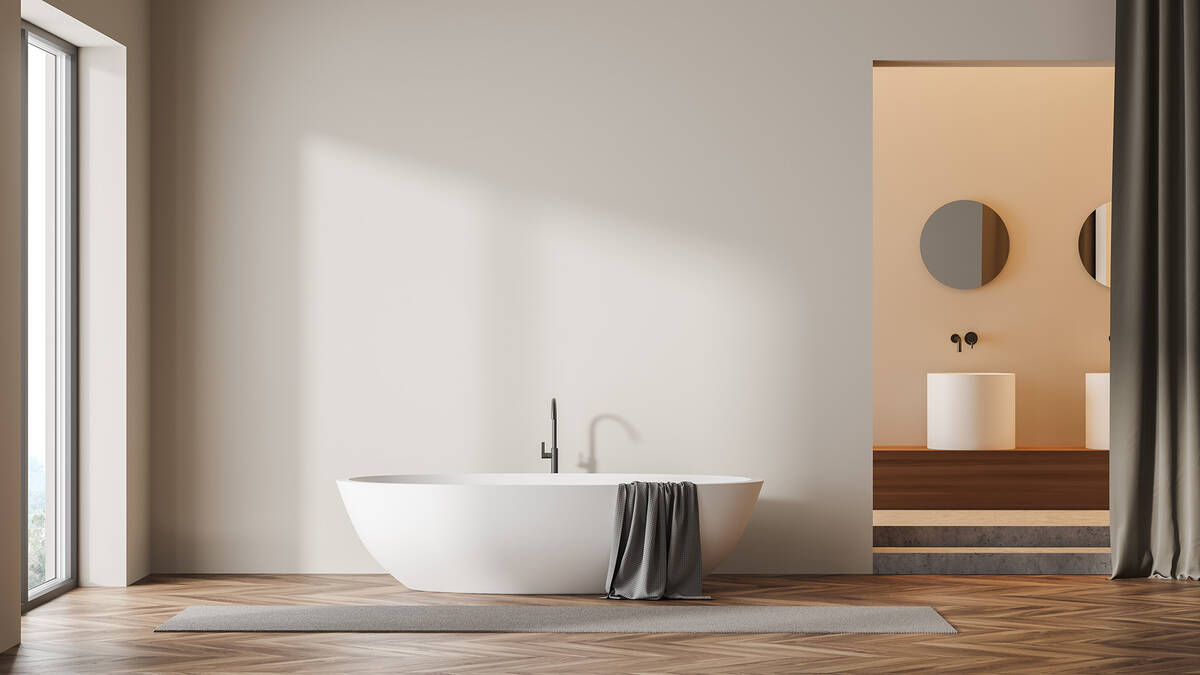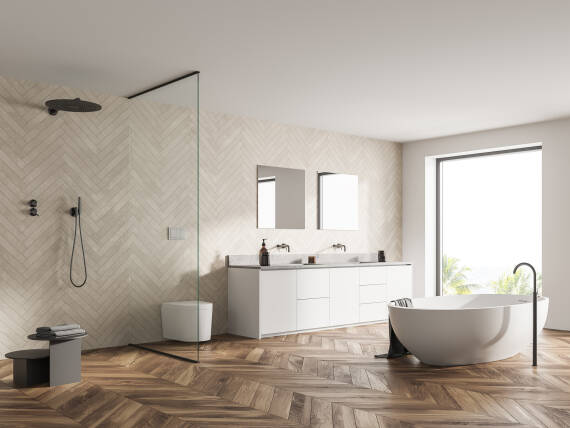If you know, you know: elegant wood flooring in the bathroom
Parquet flooring in the bathroom: elegant, practical and sturdy
Untreated wood and moisture aren’t normally a good match. However, parquet flooring can enhance the bathroom’s look and offer many benefits. What do you need to know before opting for elegant parquet flooring in the bathroom? You will find extensive information, including practical tips, in this article.

Is parquet flooring actually suitable for the bathroom?

Wood is a natural material. When it comes into contact with moisture, it absorbs as much as it can and swells. When the humidity decreases, the water evaporates and the natural material warps.
The critical value is 70 percent humidity. This limit should not be exceeded in any room, as a higher percentage usually leads to mould forming.
Nowadays, specialised surface finishes enable the elegant material to be used in wet rooms without a problem. It does, however, require slightly more care than tiles. With the right knowledge, wood flooring can last as long as other high-quality building materials.
There are many benefits to using wood as flooring:
- The natural grain creates a unique look, which increases the feel-good factor. It also feels nice and warm on the feet – unlike cold tiles or natural stone.
- Wood contains tannins, which have an antimicrobial effect. So it is not as easy for biofilm to form here.
- The close-grained material can store heat and has excellent insulating properties.
- Wood is a sustainable material because is a renewable resource. Nevertheless, we recommend taking a closer look at its source before making a purchase. This will help to prevent environmental pollution through long transportation routes.
Important information and tips for wood flooring
Not every type is suitable for wet rooms. For example, beech is one of the varieties that absorbs moisture very easily and is therefore not particularly suitable here.
The following types of wood are perfect for your bathroom
- Oak: The natural product is ultra-robust and durable.
- Walnut: This type will only expand slightly, so it is great for underfloor heating.
- Douglas fir: The North American spruce features an impressively pleasant feel and is easy to clean.
- Merbau: The tropical wood is tough and resilient.
- Teak: This Asian variety withstands moisture well and is resistant to mould growth.
Solid parquet flooring consisting of individual planks is relatively moisture-resistant as it doesn’t swell so quickly at the edges. The multiple layers offer humidity a larger attack surface, so this flooring requires attentive care in the bathroom.
During installation, we advise having all of your flooring fully glued down. The underlay with slip-resistant adhesive consists of several layers, and its installation requires good skills and craftsmanship. It is important that the underlay is perfectly sealed with an elastic joint sealant.
Varnished flooring does not require a lot of care in a normal room. But if a bit of water pools on the seal, as can happen after showering, the layer of varnish might crack. Oil is perfect for treating surfaces in the bathroom. Before first use, the flooring is treated with several layers of hard oil or hard wax oil. A polishing machine carefully rubs it in. The result is a waterproof surface finish that cannot absorb water easily. Hard oil takes hold deep in the wood’s structure to protect it from the inside out. Hard wax oil leaves a shiny protective film on the surface. No matter which option you choose, your parquet flooring should be re-oiled once a year.
If you have underfloor heating in your bathroom, you should choose thin parquet flooring. A 22 mm thickness will allow enough warmth to penetrate into the room. We strongly recommend you ask an expert whether your chosen flooring is suitable for this kind of heating.
How to take proper care of your wood flooring
With the right care, wood can last for many decades in wet rooms. When enjoying a shower or bath, please do the following:
- Mop up small puddles immediately. Any water that is left for a longer period of time can even penetrate oiled parquet flooring.
- Be mindful of the humidity. Thermo-hygrometers are great for measuring this value. And regular ventilation can help to reduce it.
- The natural material constantly expands and retracts, even if it is a wood variety that keeps its shape. If small cracks appear, they should be sealed immediately. Neoprene fillers are great for simply injecting into the cracks.
Frequently asked questions about parquet flooring in the bathroom
The humidity should be a maximum of 70 percent.
Unlike white tiles, the warm look and feel creates a cosy ambiance. It also has antimicrobial properties, insulates well and is less prone to mould.
Oak, walnut, Douglas fir, merbau and teak are suitable for wet rooms.
Hard oil or hard wax oil are better options than sealing it with varnish, as the latter can rupture.
Yes, but it shouldn’t be any thicker than 22 mm.
Bathrooms and wood flooring: How to make this combination work
Parquet is an elegant flooring material, as it creates a cosy atmosphere. It is also an antimicrobial material with good insulating properties, which also make it suitable for underfloor heating. It is important that you choose a suitable variety. With the right care, oiled parquet flooring that has been fully glued down can last for many decades, even in a wet room.
Authorised dealers